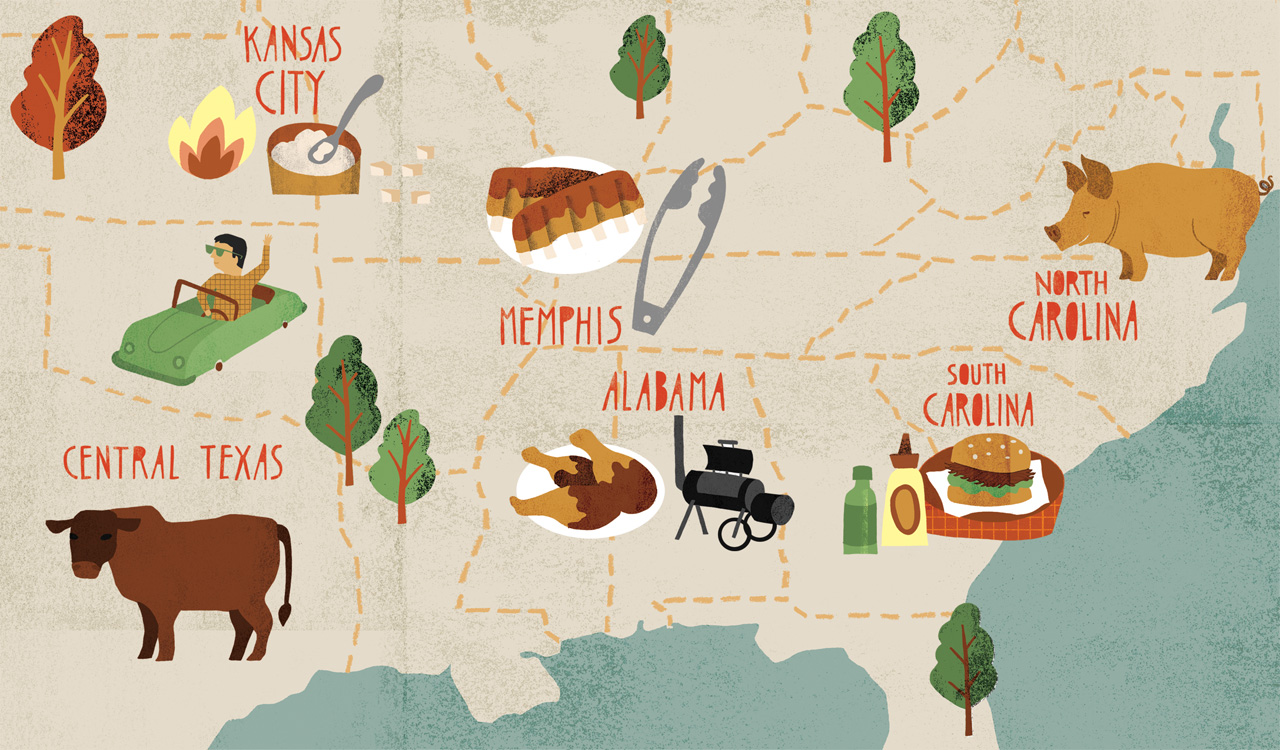The Local newsletter is your free, daily guide to life in Colorado. For locals, by locals.
In what may rank as one of the coolest work trips ever, Mike Johnston, owner of Savory Spice, embarked on a barbecue pilgrimage last summer. His goal: to do hands-on research on regional differences in barbecue. After 43 days of driving, logging 7,000 miles across 14 states, and visiting 88 barbecue joints, Johnston won’t spill on his favorite, but he’s working components from each of the distinct regions into a new line of sauces and rubs that will launch at Savory this month. Here’s what he learned, with tips from the pros themselves.
Central Texas
The Meat: All things beef—brisket, sausage, ribs
Barbecuing Method: Low and slow
Fuel: Post oak, live, or white variety
Spices/Sauce: Salt-and-pepper blends; sauces might not even be on the table
At-Home Tip: Mix mustard and pickle juice together, a 60 to 40 ratio, and lather your protein before applying a spice rub. This locks in moisture.
—Dustin Amariah Blackwell, pit master and co-owner of Hutchins BBQ and Catfish (McKinney)
Kansas City
The Meat: Pulled pork, ribs, burnt ends
Barbecuing Method: Low and slow
Fuel: Hickory, pecan, and apple
Spices/Sauce: Heavy sugar-based (usually brown sugar) rubs and sweeter tomato-based sauces
At-Home Tip: Few have time to cook for 20 hours these days. Instead, heat the smoker to 275 to 300 degrees. It’ll result in a better bark, and it’ll speed up cook time.
—Mike Pearce, co-owner and pit master of Slap’s BBQ (Kansas City)
Memphis
The Meat: Ribs, rib tips, pulled pork, smoked encased meats such as bologna and summer sausage
Barbecuing Method: Low and slow
Fuel: Hickory, pecan, apple, and briquette charcoals
Spices/Sauce: Sugar-based rubs offer heat; sweet, tangy ketchup-based sauces
At-Home Tip: With a pair of tongs, pick up your rack of ribs from the middle. If the meat starts to break away, it’s done.
—Bobby Bradley, co-owner of Cozy Corner Restaurant (Memphis)
Alabama
The Meat: Ribs, pork, and chicken
Barbecuing Method: Pork ribs cooked hot and fast at 700 to 800 degrees
Fuel: Hickory, pecan, and fruitwoods
Spices/Sauce: Chicken slathered with a mayo-and-vinegar-based white sauce; ribs come with a sweet, tangy red sauce
At-Home Tip: Barbecue at a consistent temperature. Invest in a thermometer…and stop opening the darn lid.
—Ken Hess, pit master of Big Bob Gibson Bar-B-Q (Decatur)
South Carolina
The Meat: Whole hog for chopped or pulled pork
Barbecuing Method: Low and slow
Fuel: Hickory, pecan, and fruitwoods
Spices/Sauce: Mustard-based sauces on the western side of the state; peppery vinegar-based sauces on the eastern side
At-Home Tip: Know your smoke. If it’s not white, then there’s sap in the wood. So wait for the white, then you’re ready to cook.
—Jeff Little, owner and pit master of Mike & Jeff’s BBQ (Greenville)
North Carolina
The Meat: Whole hog for chopped or pulled pork
Barbecuing Method: Low and slow
Fuel: Hickory, pecan, and fruitwoods
Spices/Sauce: Vinegar-based sauce in the east; ketchup-tinted vinegar sauce in the central and western parts of the state
At-Home Tip: Take field notes. Write down each spice combo, sauce blend, and cooking method. Even note the weather.
—Sam Jones, owner and pit master of Skylight Inn BBQ (Ayden)









